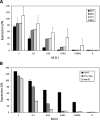Comparative purification and characterization of hepatitis B virus-like particles produced by recombinant vaccinia viruses in human hepatoma cells and human primary hepatocytes
- PMID: 30794666
- PMCID: PMC6386438
- DOI: 10.1371/journal.pone.0212800
Comparative purification and characterization of hepatitis B virus-like particles produced by recombinant vaccinia viruses in human hepatoma cells and human primary hepatocytes
Abstract
This study describes the comparative expression and purification of hepatitis B surface antigen (HBsAg) particles produced upon infection of human primary hepatocytes and human hepatoma cell lines (HuH-7 and HepG2) with recombinant vaccinia viruses. The highest levels of HBsAg expression were found in HuH-7 hepatoma cells following infection with recombinant vaccinia viruses, which contain the S gene under control of a 7.5 k-promoter. Four different methods for purification of the HBsAg particles were examined: isopycnic ultracentrifugation, sucrose cushion sedimentation, isocratic column gel filtration, and binding to anti-HBs-coated microparticles. The highest degree of purity of HBsAg particles was reached by the method based on anti-HBs-coated microparticles. The resulting product was >98% pure. Biochemical analysis and characterization of purified HBsAg particles were performed by sodium dodecyl sulfate polyacrylamide gel electrophoresis (SDS-PAGE), western blotting, and electron microscopy. The HBsAg, purified from human hepatoma cell lines and from human primary hepatocytes, consisted of both the non-glycosylated (p25) and the glycosylated (gp27) form and assembled into typical 22-nm particles, and thus may be of great interest and importance for research, diagnostics, and medical treatments.
Conflict of interest statement
The authors have declared that no competing interests exist.
Figures






Similar articles
-
Induction of Plasmodium falciparum sporozoite-neutralizing antibodies upon vaccination with recombinant Pfs16 vaccinia virus and/or recombinant Pfs16 protein produced in yeast.Mol Biochem Parasitol. 1995 Jun;72(1-2):179-92. doi: 10.1016/0166-6851(95)00072-9. Mol Biochem Parasitol. 1995. PMID: 8538688
-
Polypeptides of hepatitis B virus surface antigen produced by a hepatoma cell line.J Virol. 1979 Dec;32(3):796-802. doi: 10.1128/JVI.32.3.796-802.1979. J Virol. 1979. PMID: 92575 Free PMC article.
-
Intrahepatic hepatitis B virus large surface antigen induces hepatocyte hyperploidy via failure of cytokinesis.J Pathol. 2018 Aug;245(4):502-513. doi: 10.1002/path.5102. Epub 2018 Jul 4. J Pathol. 2018. PMID: 29862509
-
Further studies on production and characterization of HBsAg derived from a human hepatoma cell line (PLC/PRF/5).Dev Biol Stand. 1983;54:81-92. Dev Biol Stand. 1983. PMID: 6317496
-
Novel tissue and cell type-specific gene/drug delivery system using surface engineered hepatitis B virus nano-particles.Curr Drug Targets Infect Disord. 2004 Jun;4(2):163-7. doi: 10.2174/1568005043341037. Curr Drug Targets Infect Disord. 2004. PMID: 15180463 Review.
Cited by
-
Hepatitis B: Model Systems and Therapeutic Approaches.J Immunol Res. 2024 May 7;2024:4722047. doi: 10.1155/2024/4722047. eCollection 2024. J Immunol Res. 2024. PMID: 38745751 Free PMC article. Review.
References
-
- World Health Organization, World Health Organization, Global Hepatitis Programme. Global hepatitis report, 2017 [Internet]. 2017. Available: http://apps.who.int/iris/bitstream/10665/255016/1/9789241565455-eng.pdf?...
Publication types
MeSH terms
Substances
LinkOut - more resources
Full Text Sources
Medical

